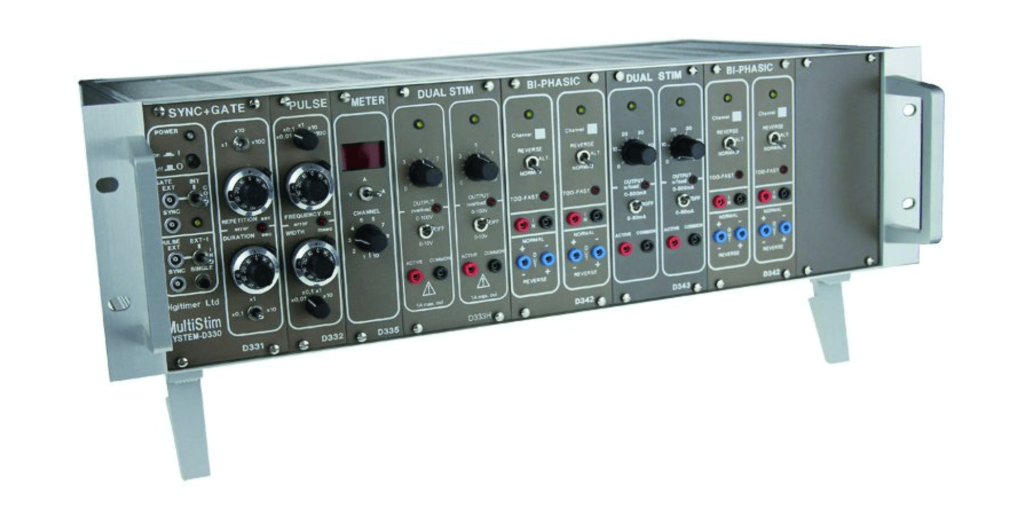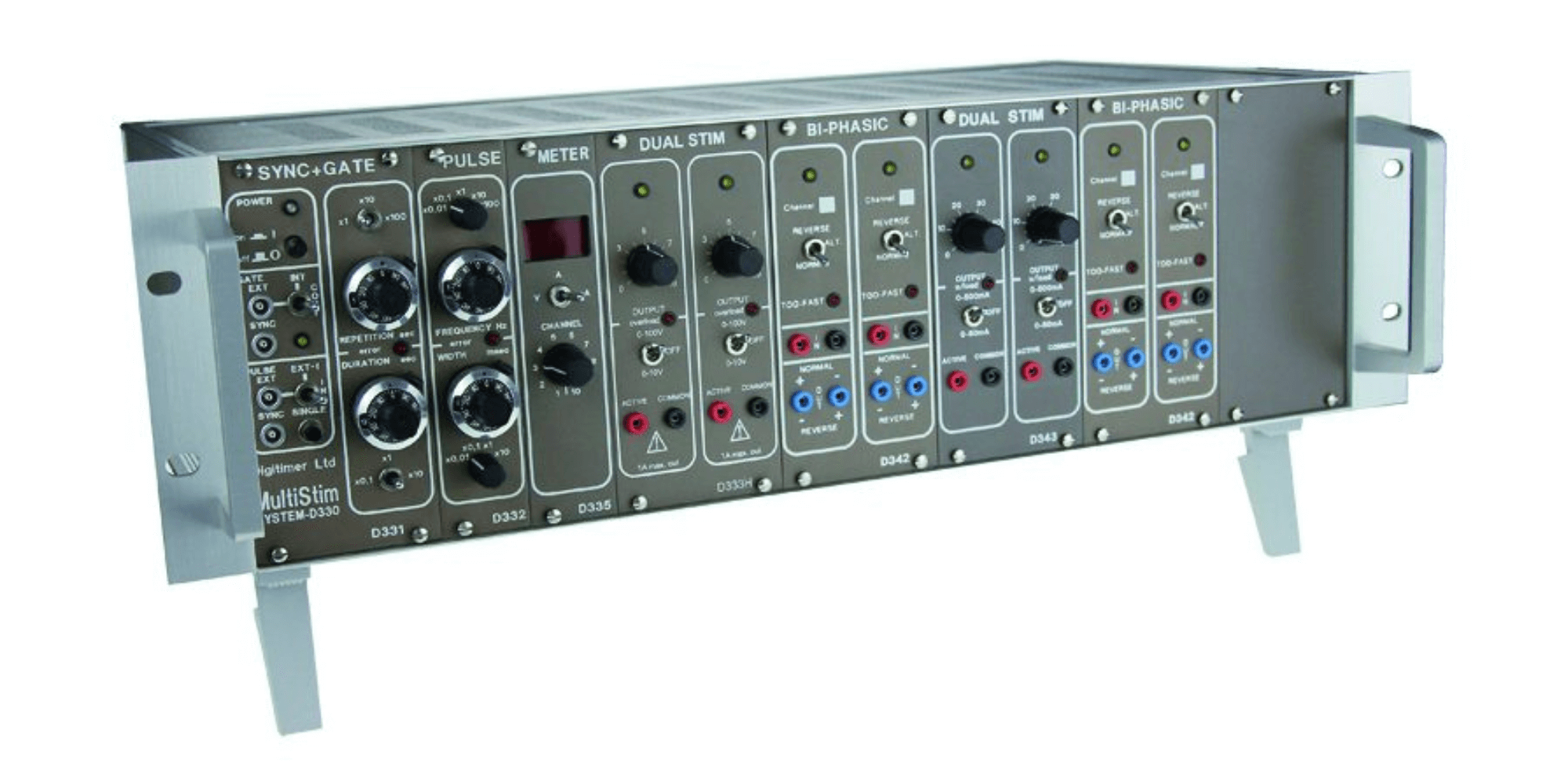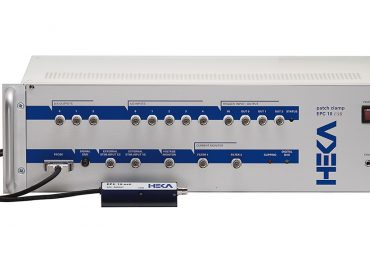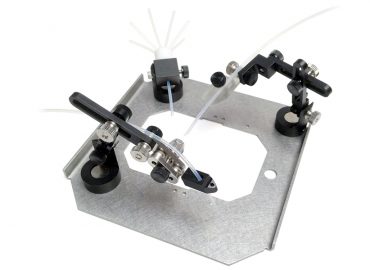The D330 Multi-Channel Stimulator
Which modules will I need?
By its very nature, the D330 multi-channel stimulator is a highly versatile system.
Designed for use in laboratories, it can accurately stimulate a number of low impedance tissue preparations. And whilst it uses a common timing waveform for all channels, different modules can be added to the system to deliver different stimuli to each preparation.
These include modules for both constant current and constant voltage stimulation.
Timing modules can also be incorporated to generate pulses – variable in frequency and width – as well as a meter, which allows precise voltage and current monitoring.

With so many options available, it’s possible to create a stimulator that’s perfectly suited to your research – which is great! But this can also make it difficult to know which you need.
Exactly which modules are best for your requirements?
To help, here our in-house experts list some of the main factors to consider. Simply follow the three steps below and develop a personalised D330 stimulator, tailored specifically to your needs.
Creating a bespoke multi-channel stimulator for your research
- Start with a case
First things first, no matter how you intend to use the D330 MultiStim, you will always need the D337 MultiStim Case and Power Supply. Essentially, this is the basic frame of the system – to which individual modules will later be added, to create a device that suits your research.
This case (or rack) is designed to accommodate 14 single-width modules and up to 10 channels of stimulation. Stimulation modules can be fitted into the double-width bays on the right, whilst the four single-width bays to the left can be used for any timing or meter modules required.
- Think carefully about your needs and answer the following questions
1. Do you wish to apply constant voltage or constant current stimulation?
Constant voltage – use one D333H Dual Stimulator for two channels of stimulation
This dual stimulator module provides constant voltage stimuli, from 0 to 100V in amplitude, with currents up to 1Amp into loads of up to 0.01µF. The voltage of the two channels can be independently controlled using single turn controls and range selector switches.
Constant current – use one D343 Dual Stimulator for two channels of stimulation
This is another dual stimulator module, very similar to the D333H – except the stimuli generated are constant current (rather than constant voltage). It provides control of stimulus strength up to 500mA from 100V into low impedance baths and, again, each channel can be independently controlled.
2. Do you want to reverse stimulus polarity between pulses?
Yes – use one D342 Dual Bi-Stim for every dual stimulator module
This is another double-width module, which provides a switching function – allowing stimuli of alternating polarity to be presented to each of the two preparations. It offers independent controls for stimulus polarity for each channel, as well as a warning for a stimulus timing rate that is too fast.
No – skip to the next question.
3. Will you be using external independent timing?
Yes – add the D344 Remote module
Fitted with a 15-pin ‘D’ connector, this module allows the user full external control of the timing, for each of the 10 possible channels in the D337 rack. A toggle switch on its interface also provides the user with an overriding ‘Enable’ control, enabling the system to be instantly disabled if necessary.
Proceed to question 5.
No – add the D332T Pulse module
For research that requires internal timing controls, this single-width module uses single turn controls and rotary switches – controlling both the frequency and duration of the stimulation pulse.
Proceed to question 4.
4. Do you require continuous pulses or bursts?
Continuous – add the D334B Sync module
This will provide the front panel Power switch, power-on/error LED, Pulse & Gate (EXT) In & Synchronisation (SYNC) sockets and a Single pulse button. Its gating circuitry has been designed carefully so that only ‘whole’ pulses are delivered to the preparations.
Bursts – add either the D331AT Sync & Gate module or the D341A Sync & Train module
In this instance, the right module for you will depend on how you’d prefer to control the burst.
The D331AT Sync & Gate is designed to control bursts by duration. It delivers repetitive bursts of pulses, and these bursts can last a set duration of time and repeat with a set repetition interval.
The D341A Sync & Train is designed to control bursts by number of pulses. It can control the gating function, so that a set number of pulses can be delivered at an accurately set repetition interval.
5. Do you need delayed or extra pulses for effective refractory period experiments
Yes – consider using the D340 Count & Delay module
This single-width module allows a stimulus pulse, of the duration set on the D332, to be added to (or be the only pulse in) the output train – at a selected ‘delay’ after a selected number of pulses.
No – skip to the next question.
6. Do you need a digital indication of the measured voltage or current?
Yes – add the D335 meter module
Last but not least, this provides a digital indication of the measured voltage or current of the stimulating waveform – therefore removing the need for an oscilloscope to measure these parameters.
The measurement channel is selected from the front panel and measurements are shown on the LED display.
No – continue to the last step.
- Fill remaining empty bays with D330-x blanks
As the D337 MultiStim Case works with internal voltages over 60V D.C, blank panels must be fitted into any unused positions – in compliance with the requirements of laboratory safety standards.
These are available in variable widths to suit your specific requirements.
Still struggling to build your ideal stimulator?
Additional resources are available throughout our website to help you narrow down the options. For example, further technical information and application guides for our multi-channel stimulator – and its associated modules – can be found in our separate D330 MultiStim System Brochure.
Detailed specifications can also be found on each product page and in our Life Science Brochure.
However, if you’re still unsure and struggling to select the ideal modules for your bespoke stimulator, please don’t hesitate to get in touch. One of our experts will gladly talk you through the features of the D337 MultiStim Case and the various modules available. Once we know a bit more about the intended application, we can help to develop the ideal D330 MultiStim for your requirements.
Just give us a call on +44 (0)1707 328347. Or, if you prefer, send an email to [email protected].




